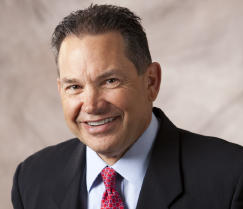SAMC: The region’s leader for stroke care
by Charles Harkness, DO, Chief Medical Officer, SAMC
 At Southeast Alabama Medical Center (SAMC), we don’t mind if some of our employees are caught watching the clock. In fact, we demand it as a Primary Stroke Center with the region’s only neuroendovascular lab. When it comes to stroke care, a timely response saves brain cells. That’s because the longer it takes for a patient to receive the appropriate treatment, the more likely there will be irreversible brain damage.
At Southeast Alabama Medical Center (SAMC), we don’t mind if some of our employees are caught watching the clock. In fact, we demand it as a Primary Stroke Center with the region’s only neuroendovascular lab. When it comes to stroke care, a timely response saves brain cells. That’s because the longer it takes for a patient to receive the appropriate treatment, the more likely there will be irreversible brain damage.
Stroke is the fifth leading cause of death in the United States. It kills almost 140,000 people each year and it is the leading cause of long-term disability.
More than 1,600 patients have trusted SAMC with stroke care during the past two years.
SAMC’s stroke program is growing. We recently recruited Dr. Joshua Sterling Bentley, a multi-specialty-trained cerebrovascular and endovascular neurosurgeon. Dr. Bentley is fellowship-trained in interventional and open surgical procedures to treat strokes. SAMC is currently recruiting a second interventional specialist to join our team, which will allow for 24/7 interventional stroke coverage.
Stroke Care Begins with Education
True comprehensive stroke care begins long before the first symptoms are noticed in a patient. It starts with public awareness of the signs of a stroke, represented by the acronym FAST, which stands for the most noticeable symptoms, including Face drooping, Arm weakness, Slurred speech, and Time.
More times than not, the person having a stroke is not the one who calls 911. It is usually a person who is familiar with the four stroke symptoms. If you suspect a person is having a stroke, call 911 immediately. Emergency Medical Technicians are familiar with stroke symptoms and their communications with a stroke ready emergency department can help ensure timely transport and appropriate care.
First Responders and Medical Teams Work Hand in Hand at SAMC
If EMTs identify a potential stroke victim who is transported to SAMC, we send out a stroke alert which engages the SAMC Stroke Team. This team is comprised of board-certified ER physicians, specialized nurses and the Radiology department. Whenever needed, an endovascular neurosurgeon, like Dr. Bentley, and a neurosurgeon are also engaged.
When a patient arrives, medical teams work swiftly to assess the patient. If a stroke is suspected, the patient is immediately taken to Radiology for a CT scan to assist in determining the best course of treatment.
Treatment may include medication, such as tissue plasminogen activator (tPA), which – if administered within four-and-a half-hours of a stroke – can dissolve the blood clot and restore blood flow to the brain.
This four and-a-half-hour treatment window is why it is important for emergency medical services to transport a stroke victim. Their services save time, which is critical.
If an interventional procedure is needed, the patient is taken to SAMC’s neuroendovascular lab, which is one of the most advanced facilities of its kind in the Southeast. This multi-million-dollar laboratory is dedicated to treating acute strokes, aneurysms, and other brain and spine conditions.
From there, stroke patients typically recover in our recently expanded Neurocritical Care Unit, where they receive care from specialized nurses.
Telemedicine Neurology Coverage
Beginning in October, SAMC will partner with neurologists at Marcus Stroke Network from the Grady Health System and the Emory University School of Medicine in Atlanta to provide 24/7 telemedicine neurology coverage.
Regional Collaboration & High Flying Care
SAMC has also partnered with five other area hospitals that are part of our stroke network, including: Medical Center Barbour in Eufaula, Dale Medical Center in Ozark, Troy Regional Medical Center in Troy, Mizell Memorial Hospital in Opp and Wiregrass Medical Center in Geneva.
This collaboration allows patients in outlying areas to go to the nearest hospital for initial diagnosis. If appropriate, the neurologist can prescribe tPA through telemedicine before transporting the patient to a stroke designated hospital, such as SAMC, for more advanced treatment and care.
This fall, SAMC will expand its stroke coverage footprint from southwest Georgia to the Florida Panhandle to the Mississippi state line as Survival Flight Inc., the region’s new air medical transport, opens its newest location in this region.
Quality Stroke Care
SAMC earned advanced certification for primary stroke centers from DNV and the Gold Plus Get With The Guidelines from the American Heart Association/American Stroke Association, as well as the Target Stroke Honor Roll Elite Award.
SAMC is dedicated to providing the highest standard of stroke care to patients in a timely manner. The stroke committee, which consists of more than 40 SAMC physicians and staff, focuses on continuous quality improvement. This team’s goal and the next step in our journey is for SAMC to become accredited as a Comprehensive Stroke Center. Achieving this goal will take time and a commitment of additional resources. It’s an investment that we think is worth making for our community, the region and the Southeast.
______________________________________________
This is part of an ongoing series covering the impact of changes in healthcare in our region.

